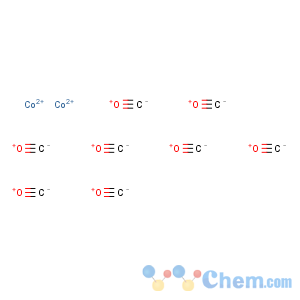Title: Dicobalt Octacarbonyl
CAS Registry Number: 10210-68-1
CAS Name: Di-m-carbonylhexacarbonyldicobalt
Synonyms: octacarbonyldicobalt; cobalt tetracarbonyl; cobalt octacarbonyl
Molecular Formula: C8Co2O8
Molecular Weight: 341.95
Percent Composition: C 28.10%, Co 34.47%, O 37.43%
Line Formula: Co2(CO)8
Literature References: Prepn: Mond
et al., J. Chem. Soc. 97, 798 (1910); Gilmont, Blanchard,
Inorg. Synth. 2, 238 (1946); Wender
et al., ibid. 5, 190 (1957); Chini
et al., Chim. Ind. (Milan) 55, 120 (1973). Crystal structure: Sumner
et al., Acta Crystallogr. 17, 732 (1964). Two isomeric forms exist in soln: Noack,
Spectrochim. Acta 19, 1925 (1963); Bor,
ibid. 2065; Noack,
Helv. Chim. Acta 47, 1064, 1555 (1964). Toxicity studies: Kincaid
et al., Arch. Ind. Hyg. Occup. Med. 10, 210 (1954); Brief
et al., Arch. Environ. Health 23, 373 (1971); Kalekin,
C.A. 78, 67751z (1973); Spiridonova, Shabalina,
Gig. Sanit. 1973, 73,
C.A. 78, 119835b (1973). Reviews of prepn, properties and chemistry of cobalt carbonyls: I. Wender
et al., Bull. U.S. Bur. Mines 600, 83 pp (1960);
Organic Syntheses via Metal Carbonyls vol. 1, I. Wender, P. Pino, Eds. (Interscience, New York, 1968)
passim; Chalk, Harrod, "Catalysis by Cobalt Carbonyls" in
Adv. Organomet. Chem. 6, 119-170 (1968); Nicholls in
Comprehensive Inorganic Chemistry vol. 3, J. C. Bailar, Jr.
et al., Eds. (Pergamon Press, Oxford, 1973) pp 1059-1064.
Properties: Orange platelets obtained by vacuum sublimation. d 1.87. mp 51°; dec above 52°. Stable in an atm of H2 and CO; dec on exposure to air. Insol in water. Sol in organic solvents such as ether, alcohol, CS2, naphtha. Slowly attacked by HCl, H2SO4, more rapidly by HNO3, Br2. LD50 in mice, rats (mg/kg): 377.7, 753.8 by gavage (Spiridonova, Shabalina).
Melting point: mp 51°
Density: d 1.87
Toxicity data: LD50 in mice, rats (mg/kg): 377.7, 753.8 by gavage (Spiridonova, Shabalina)
Derivative Type: Cobalt carbonyl hydride
Synonyms: Cobalt hydrocarbonyl; tetracarbonylhydridocobalt; tetracarbonylhydrocobalt
Molecular Formula: C4HCoO4
Molecular Weight: 171.98
Percent Composition: C 27.94%, H 0.59%, Co 34.27%, O 37.21%
Literature References: Unstable catalytic intermediate; active species in some reactions catalyzed by Co2(CO)8.
Properties: Yellow, toxic, foul-smelling liquid. mp -26°. Dec at room temp to Co2(CO)8. Sparingly sol in water (3 ′ 10-3 moles/l); behaves as a strong acid. Readily oxidized in air.
Melting point: mp -26°
CAUTION: Potential symptoms of overexposure are irritation of eyes, skin, mucous membranes; cough, decreased pulmonary function, wheezing, dyspnea.
See NIOSH Pocket Guide to Chemical Hazards (DHHS/NIOSH 97-140, 1997) p 74.
Use: Catalyst for hydroformylation, hydrogenation, hydrosilation, isomerization, carboxylation, carbonylation and polymerization reactions.

